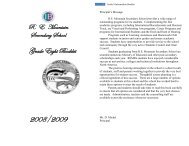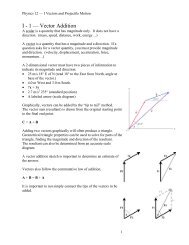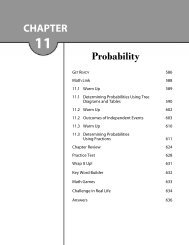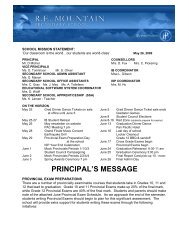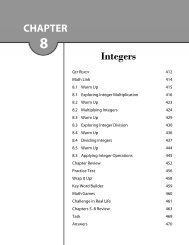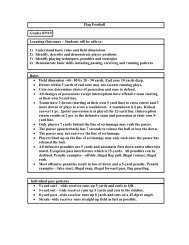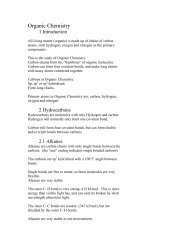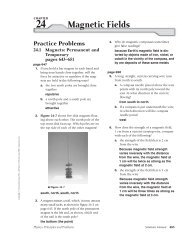Ch 12 Answers
Ch 12 Answers
Ch 12 Answers
Create successful ePaper yourself
Turn your PDF publications into a flip-book with our unique Google optimized e-Paper software.
<strong>Ch</strong>apter <strong>12</strong> continued<br />
Mixed Review<br />
pages 337–338<br />
Level 1<br />
67. What is the efficiency of an engine that produces<br />
2200 J/s while burning enough gasoline<br />
to produce 5300 J/s? How much waste<br />
heat does the engine produce per second?<br />
Efficiency 100 2<br />
W<br />
200<br />
J<br />
100<br />
QH<br />
5300<br />
J<br />
42%<br />
The heat loss is<br />
5300 J 2200 J 2900 J<br />
68. Stamping Press A metal stamping machine<br />
in a factory does 2100 J of work each time it<br />
stamps out a piece of metal. Each stamped<br />
piece is then dipped in a 32.0-kg vat of water<br />
for cooling. By how many degrees does the<br />
vat heat up each time a piece of stamped<br />
metal is dipped into it?<br />
If we assume the 2100 J of work from<br />
the machine is absorbed as thermal<br />
energy in the stamped piece, then the<br />
vat must absorb 2100 J in the form of<br />
heat from each piece. No work is done<br />
on the water, only heat is transferred.<br />
The change in temperature of the water<br />
is given by<br />
U mCT,<br />
U<br />
therefore T mC<br />
<br />
2100 J<br />
<br />
(32.0 kg)(4180 J/kg°C)<br />
0.016°C.<br />
69. A 1500-kg automobile comes to a stop<br />
from 25 m/s. All of the energy of the<br />
automobile is deposited in the brakes.<br />
Assuming that the brakes are about 45 kg<br />
of aluminum, what would be the change<br />
in temperature of the brakes?<br />
The energy change in the car is<br />
KE 1<br />
2 (1500 kg)(25 m/s)2 4.710 5 J.<br />
If all of this energy is transferred<br />
as work to the brakes, then<br />
U KE mCT.<br />
Therefore, T KE<br />
<br />
mC<br />
<br />
<strong>12</strong>°C<br />
70. Iced Tea To make iced tea, you start by<br />
brewing the tea with hot water. Then you<br />
add ice. If you start with 1.0 L of 90°C tea,<br />
what is the minimum amount of ice needed<br />
to cool it to 0°C? Would it be better to let<br />
the tea cool to room temperature before<br />
adding the ice?<br />
Heat lost by the tea<br />
Q mCT<br />
(1.0 kg)(4180 J/kgK)(90°C)<br />
376 kJ<br />
Amount of ice melted<br />
m <br />
Q<br />
Hf<br />
376 kJ<br />
1.1 kg<br />
334 kJ<br />
Thus, you need slightly more ice than<br />
tea, but this ratio would make watery<br />
tea. Let the tea cool to room temperature<br />
before adding the ice.<br />
Level 2<br />
71. A block of copper at 100.0°C comes in contact<br />
with a block of aluminum at 20.0°C, as<br />
shown in Figure <strong>12</strong>-21. The final temperature<br />
of the blocks is 60.0°C. What are the<br />
relative masses of the blocks?<br />
100.0°C<br />
Copper Aluminum<br />
60.0°C<br />
4.710 5 J<br />
<br />
(45 kg)(897 J/kg°C)<br />
20.0°C<br />
60.0°C<br />
Copper Aluminum<br />
■ Figure <strong>12</strong>-21<br />
282 Solutions Manual Physics: Principles and Problems<br />
Copyright © Glencoe/McGraw-Hill, a division of The McGraw-Hill Companies, Inc.





